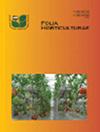Effect of saline water on the vase life of Narcissus poeticus L. flowers
IF 2.2
4区 农林科学
Q2 HORTICULTURE
引用次数: 0
Abstract
The vase life of Narcissus poeticus flowers collected at the white bud stage was investigated in 13 different concentrations of NaCl (0–5–10–15–20–30–40–…–100 mM). Every 12 hr, the opening stage of the flowers was recorded, divided into 4 main categories (bud, opening flower, full open (FO) flower and wilting flower) and 14 subcategories. The salinity did not affect the flower opening speed, diameter or weight. The duration of the full flowering stage decreased from 92 hr to 44 hr, the sum of the daily ornamental value score (OVS) decreased from 120 by 3 scores per each 10 mM concentration increase. The scape chlorophyll content increased at low salinity (10–15 mM) and then decreased significantly. The carotenoid content in the scapes of wilted flowers increased in 30–100 mM solutions compared to the values in the flowering stage and flowers grown at lower salt concentrations. The Na and Cl contents in the plant parts increased significantly with the increase in salinity (at the end of the experiment, 100 mM NaCl: scapes: 44.1 g · kg-1 and 67.2 g · kg-1 Na and Cl; flowers: 16.8 g · kg-1 and 24.8 g · kg-1 Na and Cl, respectively). There was an inverse correlation between the Na and K contents in the scapes. The EC value of the vase solutions decreased during the experiment.盐水对水仙花花瓶寿命的影响
研究了在 13 种不同浓度的 NaCl(0-5-10-15-20-30-40-...-100 mM)中采集的白色花蕾期水仙花的花瓶寿命。每 12 小时记录一次花朵的开放阶段,分为 4 大类(花蕾、开放花朵、完全开放(FO)花朵和枯萎花朵)和 14 个小类。盐度对花的开放速度、直径和重量没有影响。盛花期的持续时间从 92 小时减少到 44 小时,每增加 10 毫摩尔浓度,每日观赏价值得分(OVS)总和从 120 分减少 3 分。花葶叶绿素含量在低盐度(10-15 毫摩尔)时增加,随后显著下降。在 30-100 毫摩尔溶液中,枯萎花葶的类胡萝卜素含量比开花期和在较低盐浓度下生长的花朵中的含量要高。随着盐度的增加,植物各部分的 Na 和 Cl 含量也明显增加(实验结束时,100 mM NaCl:花葶:44.1 g - kg-1 和 67.2 g - kg-1 Na 和 Cl;花:16.8 g - kg-1 和 67.2 g - kg-1 Na 和 Cl):Na 和 Cl 分别为 16.8 克-千克-1 和 24.8 克-千克-1)。花葶中 Na 和 K 的含量成反比。在实验过程中,花瓶溶液的导电率值有所下降。
本文章由计算机程序翻译,如有差异,请以英文原文为准。
求助全文
约1分钟内获得全文
求助全文
来源期刊

Folia Horticulturae
Agricultural and Biological Sciences-Horticulture
CiteScore
3.40
自引率
0.00%
发文量
13
审稿时长
16 weeks
期刊介绍:
Folia Horticulturae is an international, scientific journal published in English. It covers a broad research spectrum of aspects related to horticultural science that are of interest to a wide scientific community and have an impact on progress in both basic and applied research carried out with the use of horticultural crops and their products. The journal’s aim is to disseminate recent findings and serve as a forum for presenting views as well as for discussing important problems and prospects of modern horticulture, particularly in relation to sustainable production of high yield and quality of horticultural products, including their impact on human health.
 求助内容:
求助内容: 应助结果提醒方式:
应助结果提醒方式:


